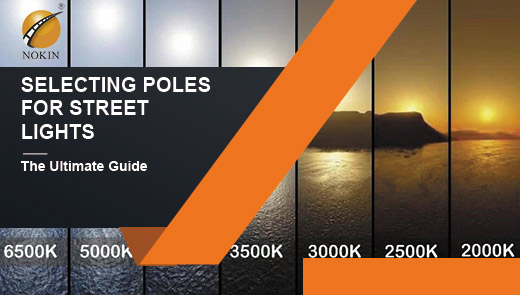How to Design and Calculate Solar Street Light System?
Feb 21, 2025
In the era of advocating green and sustainable development, solar street light, as a kind of efficient and clean lighting solution, is gradually emerging in the field of road lighting. It not only effectively reduces dependence on traditional electricity and lowers carbon emissions, but also provides reliable lighting services for remote areas. But have you ever wondered how a well-performing solar street light system is designed and calculated? Next, let's delve into the mystery.

Solar Powered Street Lamp System
1. Solar panel
Solar panel is the energy collector of the solar street light system, which utilizes the principle of photoelectric effect to convert solar energy into electricity under sunlight irradiation. The calculation of its generating capacity is closely related to the power required for lighting and the length of lighting. For example, if an area needs to be illuminated for a long period of time and at a high level of brightness, a solar panel with higher power and higher conversion efficiency is required to meet the power demand.
2. Battery
Batteries play a key role in energy storage in solar street light systems. When there is sunlight during the day, the electricity generated by solar cells will be stored in the battery for use by street lights at night or on cloudy days. The determination of the battery capacity is not arbitrary, but a comprehensive consideration of the power generation of the solar cell, the power of the LED lamp and the duration of lighting and other factors. Only accurate matching can ensure that the street light can operate stably under various circumstances.
3. Charge controller
Charge controller is like the solar street light system “intelligent housekeeper”. It can precisely control the charging process during the period of sufficient sunlight and long light hours. When the battery is fully charged, it will automatically stop charging to avoid overcharging the battery, so as to effectively protect the battery, prolong its service life and guarantee the stable operation of the whole system.
4.LED controller
LED controller is the core control circuit of LED street light. It has a number of key functions: first of all, it can realize the constant current drive control of the LED to ensure that the current flowing through the LED is not affected by the fluctuation of the battery voltage, and the stable current helps to prolong the service life of the LED and ensure the lighting effect; secondly, it has a light control function, which can automatically control the switch of the street lamp according to the ambient light and turn off the lamp automatically during the daytime when there is enough light, and turn on the lamp automatically at night when the light becomes dark; furthermore, it has a low-voltage protection function, which can be used when the light is sufficient. With low voltage protection function, when the battery voltage drops to 10.8V, it will automatically cut off the output to prevent the battery from being damaged due to over-discharge.
5.LED Lighting Fixtures
LED lighting fixtures have become the ideal choice for solar street lights with their high luminous efficiency and long life. At present, the LED light source used in solar street lights is usually a modular structure composed of multiple LEDs. This structure not only facilitates installation and maintenance, but also allows flexible adjustment of the power and brightness of the lamps according to different lighting requirements.
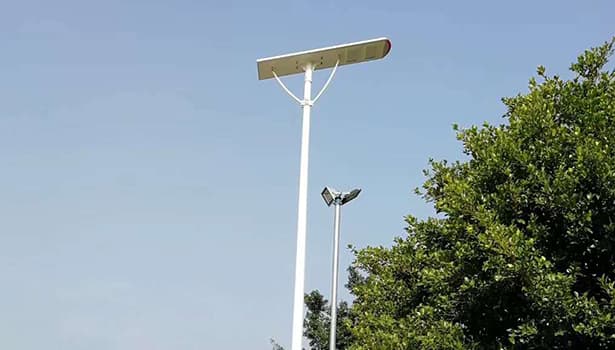
Determine what is power consumption of your street light
1. Define the components that need to be powered
In the design of solar street light system, the first task is to define all the components that need to be powered by solar energy. In addition to the core LED lights, some street lights with intelligent functions may also need to power WiFi modules, surveillance cameras and other equipment. These additional power-using devices will increase the overall power consumption of the system and must be fully considered during design.
2. Calculate the daily watt-hours of each component
Calculating the daily watt-hours of each component is the basis for determining the total power consumption of the system. Calculating the daily watt-hours of each component is the basis for determining the total power consumption of the system. The specific method is to multiply the power (unit: watt, W) of each component by its daily usage hours (unit: hour, h). For example, if a WiFi module with a power of 10W is used for 12 hours a day, then its daily watt-hours is 10W×12h = 120Wh.
3. Get the total daily watt-hours of the solar street lighting system
Add up the daily watt-hours of all the components that need to be supplied with power to get the total watt-hours required by the whole system every day. This value reflects the daily energy consumption of the solar street light system, and is an important basis for the subsequent calculation of solar panel power and battery capacity.
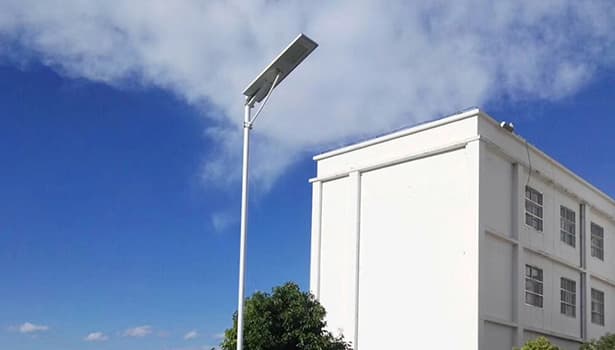
Calculation of required power for solar panels
1. Calculation process
To 50W LED solar street lamp as an example, assuming that the cumulative lighting needs to be 9 hours (h) per night, while setting the local daily effective solar light hours for 6 hours (the effective light hours in different areas will vary). In order to ensure the normal operation of the street light, we also need to consider a certain amount of margin, usually at least 20% of the extra amount should be reserved. The calculation process is as follows:
First, calculate the daily power required by the street light as 50W×9h = 450Wh. Considering the energy loss in the system, multiply this value by 1.3 (i.e., the system loss coefficient), and we get 450Wh×1.3 = 585Wh, which is the power that needs to be supplied by the solar panels on a daily basis.
Then, the power of the solar panel is WP, the working voltage of the solar panel is generally known to be 17.4V, according to the formula WP ÷ 17.4V = (4.17A × 7.5h × 120%)÷6h (of which 4.17A is the current calculated according to the power and voltage, 7.5h is the equivalent length of time of the illumination after taking into account the residual amount, and 120% is the 20% extra amount set aside), after calculation WP = 109 (W).
2. Considering the actual loss of the value
In the actual solar street lamp assembly process, there will inevitably be wire loss, controller loss and ballast or constant current source loss. These losses are usually around 15% - 25%. Therefore, although the theoretical calculation of the solar panel power of 109W, but in practice, in order to ensure the stable operation of the system, usually choose 120W solar panels as a safer and more reliable solution.
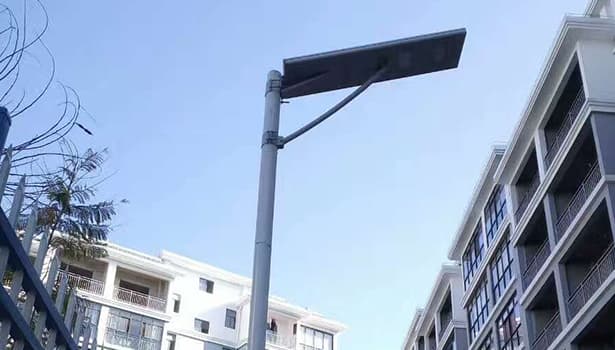
Battery of solar street lighting systems – capacity and type
1. Comparison of Recommended Battery Types and Characteristics
In solar photovoltaic systems, the deep-cycle battery is the more recommended battery type. It is specially designed for fast charging after discharging at low energy levels, or continuous charging and discharging for many years. Common batteries for solar street light systems are mainly lead-acid batteries and lithium batteries (including lithium iron phosphate LiFePO4). Lead-acid battery cost is low, but there are short life, low depth of discharge shortcomings; lithium batteries, although the cost is relatively high, but its long life, good security, high depth of discharge, can better meet the long-term stable operation of the solar street light system.
2. Battery capacity calculation formula and the meaning of the parameters
To calculate the battery capacity of the formula: the required battery capacity (Wh) = total watt-hours (per day) × days of autonomous operation / 0.9 / depth of discharge of deep-cycle batteries. The total watt-hours per day is the total daily energy consumption of the system calculated earlier; 0.9 is the coefficient used to calculate the battery loss; the discharge depth of the deep-cycle battery is generally calculated at 0.7 for lead-acid batteries and 0.8 for lithium batteries; and the number of days of autonomy refers to the number of days that the system needs to continue to operate without the PV panels to generate electricity.
3. Calculation results
Assume that through the previous calculations, the total daily watt-hours of the system is 400Wh, and it is necessary to ensure that the system can still work normally in the absence of sunlight for 3 consecutive days (i.e., 3 days of autonomous operation). If lead-acid batteries are used, according to the formula, the required battery capacity is 400Wh × 3 / 0.9 / 0.7 ≈ 1905Wh. For 12V lead-acid batteries, their capacity should be 1905Wh ÷ 12V ≈ 159AH, and to be on the safe side, 180AH batteries are usually rounded up. If lithium batteries are used, the calculation process is 400Wh×3 / 0.9 / 0.8 = 1667Wh, for 12V lithium batteries, the capacity should be 1667Wh ÷ 12V ≈ 139AH, and 150AH lithium batteries are usually chosen.

Solar street light installation design
1. Geographic latitude on the configuration
Different countries and regions with different geographic locations and latitudes, which will directly affect the configuration of solar panels and batteries in the solar street light system. In high latitudes, the sun's altitude angle is small, the light time is relatively short, in order to get enough solar energy, it may need a larger area of solar panels and a larger capacity of the battery; while in low latitudes, the light conditions are better, the configuration of solar panels and batteries can be relatively small.
2. The role of solar panel adjustability
When installing solar street lights, the orientation of the solar panel is crucial. If the solar panel can be adjusted according to the position of the sun, it can maximize the absorption of solar energy and improve the efficiency of solar energy conversion. In contrast, fixed low-quality solar LED street light panels will not only have low solar energy conversion efficiency, but also the applicable installation area will be limited. Therefore, when designing a solar street light project, make sure that the solar panels on both sides of the road can fully face the sun.
3. Determine the lighting needs and design strategy according to the scene
According to different lighting scenes, the design strategy of solar street light is also different. In highways, airports and other areas with high personnel and vehicle traffic, the brightness and stability of the lighting requirements are higher. For example, on highways, customers usually require the street light to be illuminated continuously at 100% brightness for 12 hours at night, and to be able to work normally during 3-4 consecutive rainy days. It is difficult for conventional solar street lights to meet such demands, and it is necessary to consider increasing the size of solar panels and battery capacity, or by increasing the battery capacity of solar street lights and reducing the LED power to realize. In parks, rural roads and other areas with relatively low traffic flow, the lighting demand is relatively low, in order to save costs and energy, the government can consider using conventional solar street lights.
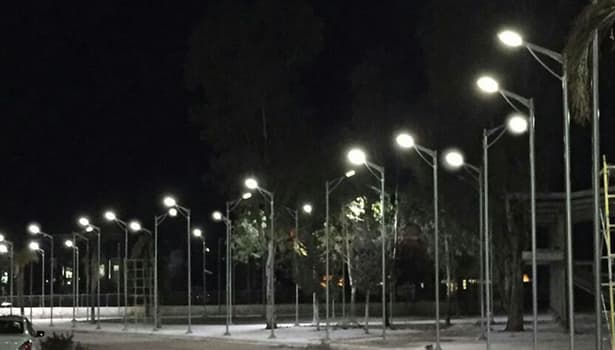
Summarize
The design and calculation of a set of solar street light system is a comprehensive project, need to comprehensively consider the characteristics of the system components, power consumption calculations, the precise determination of the parameters of each component and the installation design and many other aspects. Only scientific and reasonable design and calculation can ensure that the solar street light system can realize efficient, stable and economic operation while meeting the lighting demand. This not only helps to reduce the cost of road lighting and the impact on the environment, but also creates a greener and more convenient traveling environment for us. We hope that through the introduction of this article, we can let you have a deeper understanding of the design and calculation of solar street light system, and jointly promote the wide application of solar street light in more fields.

